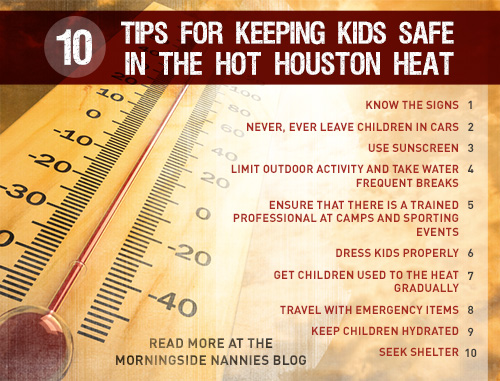10 Tips for Keeping Kids Safe in the Hot Houston Heat
 Heat exhaustion and other heat related illnesses are serious threats to children during Houston’s blazing summers. In fact, heat is the number one weather-related killer in the US, according to the National Oceanic and Atmospheric Administration. The American Academy of Pediatrics states that most instances of heat stroke can be prevented with preparation and proper monitoring, which is good news for parents of active kids living in Houston. Here are some important tips to keeping your kids safe this summer.
Heat exhaustion and other heat related illnesses are serious threats to children during Houston’s blazing summers. In fact, heat is the number one weather-related killer in the US, according to the National Oceanic and Atmospheric Administration. The American Academy of Pediatrics states that most instances of heat stroke can be prevented with preparation and proper monitoring, which is good news for parents of active kids living in Houston. Here are some important tips to keeping your kids safe this summer.
1. Know the Signs
It is important to know the signs of heat related illness so that you can act fast if you see them in your child. If your child is dehydrated they will have a dry sticky mouth, decreased urine output, and appear tired. If it gets worse, your child will have no liquid output at all, not even sweat or tears, and they could have a fever or low blood pressure. If you suspect dehydration, seek medical help and cool and hydrate your child any way you can. Mild heat cramps will display with muscle pain and spasms. If you see this, get your child out of the sun and give her water. Heat exhaustion will show as extreme fatigue, dizziness, changes in pulse, pale skin, and headache. If you see any of these, or other unnerving signs, get your child out of the sun and give him water. Cool his body by removing excess clothing and by dabbing the skin with cool, damp towels. If this does not help within twenty minutes, call your pediatrician. Symptoms of a heatstroke are a temperature of over 104°, red skin, disorientation, seizures, and loss of consciousness. If you think you see any of these signs in your child, call 911 right away.
2. Never, Ever Leave Children in Cars
Since 1998, there have been five hundred and seventy heatstroke deaths resulting from children being left in cars. A car feels like a sauna on hot days. If you do not have adequate air conditioning in your car, try not to travel with your children during the hottest hours of the day (typically between ten in the morning and four in the afternoon). Before getting in the car, start it and run the air conditioning to cool down seats and seatbelts. Never leave a child in the car, not even for a minute while you run into a store or talk to a friend. Keep your vehicle doors and trunk locked at all times when the car is not in use to prevent a child from playing in the vehicle and accidentally getting locked in. To ensure you do not forget your child in the car, leave items you need in the backseat next to them such as your cell phone, briefcase, or purse.
3. Use Sunscreen
Apply a broad-spectrum (UVA/UVB) sunscreen to children every two hours when outside. Even if it is a cloudy day, sunscreen is still necessary. Dress infants aged 6 months and younger in protective clothing, keep them in the shade and only apply sunscreen to small, exposed parts of the body if protective clothing and shade is not available.
4. Limit Outdoor Activity and Take Water Frequent Breaks
It’s a good idea to limit the outdoor activity to the hours when the sun is not at its strongest, such as before ten in the morning or after four in the afternoon. Have your child take frequent water breaks while playing outdoors by coming inside into the air conditioning or retreating to the shade to dissipate some of the body’s extra heat.
5. Ensure That There is a Trained Professional at Camps and Sporting Events
It is very important that day camps and sporting events have a trained professional on staff that knows how to recognize and respond to heat illnesses.
6. Dress Kids Properly
Dress your children in loose fitting clothing made from a thin material. Have your kids wear light colors that reflect the sun’s rays, rather than dark colors that absorb them. A wide brimmed hat, preferably a sun or straw hat is best to protect the head.
7. Get Children Used to the Heat Gradually
Kids often respond better to the heat when they’re exposed to it gradually. For example, on the first day of hot weather, you would not want your child spending hours vigorously exercising outdoors. You’d want him to spend a very short amount of time outdoors and then spend a bit longer outside on the next day. This is especially important for kids playing sports over the summer.
8. Travel With Emergency Items
If you are out and about with your little ones on a hot day, you will want to carry the following items with you: extra water, instant ice packs, thermometers, and sunscreen. These would be in addition to your usual first aid items such as bandages and tweezers.
9. Keep Children Hydrated
Kids should drink two full glasses of water before going outside and then drink every twenty minutes while out there. Have them replenish themselves fully afterwards with at least another two glasses. Do not give children caffeinated beverages or beverages with sugar, which includes juice and fruit drinks. Sports drinks are okay, but it’s always best to check with a doctor as some contain a high amount of sodium and other questionable ingredients.
10. Seek Shelter
The best way to prevent heat stroke is by simply staying out of the heat. Keeping kids home in the air conditioning, or taking them to air conditioned places such as indoor play facilities, the mall, the movies, or the library are all great ways to get them out of the sweltering heat. You can make arrangements to be transported to Houston’s library by calling 3-1-1.
← 10 Places to Go for a Mom’s Night Out in Houston | 6 of the Best Family Photographers in Houston →
Comments are closed.

 Heat exhaustion and other heat related illnesses are serious threats to children during Houston’s blazing summers. In fact, heat is the number one weather-related killer in the US, according to the National Oceanic and Atmospheric Administration. The American Academy of Pediatrics states that most instances of heat stroke can be prevented with preparation and proper monitoring, which is good news for parents of active kids living in Houston. Here are some important tips to keeping your kids safe this summer.
Heat exhaustion and other heat related illnesses are serious threats to children during Houston’s blazing summers. In fact, heat is the number one weather-related killer in the US, according to the National Oceanic and Atmospheric Administration. The American Academy of Pediatrics states that most instances of heat stroke can be prevented with preparation and proper monitoring, which is good news for parents of active kids living in Houston. Here are some important tips to keeping your kids safe this summer.
